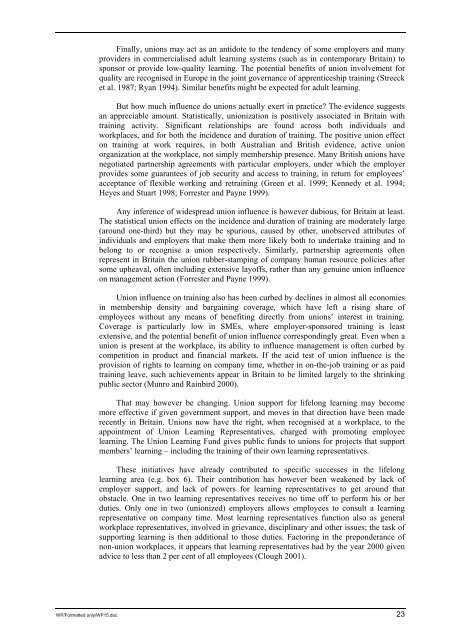Lifelong learning - International Labour Organization
Lifelong learning - International Labour Organization
Lifelong learning - International Labour Organization
Create successful ePaper yourself
Turn your PDF publications into a flip-book with our unique Google optimized e-Paper software.
Finally, unions may act as an antidote to the tendency of some employers and many<br />
providers in commercialised adult <strong>learning</strong> systems (such as in contemporary Britain) to<br />
sponsor or provide low-quality <strong>learning</strong>. The potential benefits of union involvement for<br />
quality are recognised in Europe in the joint governance of apprenticeship training (Streeck<br />
et al. 1987; Ryan 1994). Similar benefits might be expected for adult <strong>learning</strong>.<br />
But how much influence do unions actually exert in practice? The evidence suggests<br />
an appreciable amount. Statistically, unionization is positively associated in Britain with<br />
training activity. Significant relationships are found across both individuals and<br />
workplaces, and for both the incidence and duration of training. The positive union effect<br />
on training at work requires, in both Australian and British evidence, active union<br />
organization at the workplace, not simply membership presence. Many British unions have<br />
negotiated partnership agreements with particular employers, under which the employer<br />
provides some guarantees of job security and access to training, in return for employees’<br />
acceptance of flexible working and retraining (Green et al. 1999; Kennedy et al. 1994;<br />
Heyes and Stuart 1998; Forrester and Payne 1999).<br />
Any inference of widespread union influence is however dubious, for Britain at least.<br />
The statistical union effects on the incidence and duration of training are moderately large<br />
(around one-third) but they may be spurious, caused by other, unobserved attributes of<br />
individuals and employers that make them more likely both to undertake training and to<br />
belong to or recognise a union respectively. Similarly, partnership agreements often<br />
represent in Britain the union rubber-stamping of company human resource policies after<br />
some upheaval, often including extensive layoffs, rather than any genuine union influence<br />
on management action (Forrester and Payne 1999).<br />
Union influence on training also has been curbed by declines in almost all economies<br />
in membership density and bargaining coverage, which have left a rising share of<br />
employees without any means of benefiting directly from unions’ interest in training.<br />
Coverage is particularly low in SMEs, where employer-sponsored training is least<br />
extensive, and the potential benefit of union influence correspondingly great. Even when a<br />
union is present at the workplace, its ability to influence management is often curbed by<br />
competition in product and financial markets. If the acid test of union influence is the<br />
provision of rights to <strong>learning</strong> on company time, whether in on-the-job training or as paid<br />
training leave, such achievements appear in Britain to be limited largely to the shrinking<br />
public sector (Munro and Rainbird 2000).<br />
That may however be changing. Union support for lifelong <strong>learning</strong> may become<br />
more effective if given government support, and moves in that direction have been made<br />
recently in Britain. Unions now have the right, when recognised at a workplace, to the<br />
appointment of Union Learning Representatives, charged with promoting employee<br />
<strong>learning</strong>. The Union Learning Fund gives public funds to unions for projects that support<br />
members’ <strong>learning</strong> – including the training of their own <strong>learning</strong> representatives.<br />
These initiatives have already contributed to specific successes in the lifelong<br />
<strong>learning</strong> area (e.g. box 6). Their contribution has however been weakened by lack of<br />
employer support, and lack of powers for <strong>learning</strong> representatives to get around that<br />
obstacle. One in two <strong>learning</strong> representatives receives no time off to perform his or her<br />
duties. Only one in two (unionized) employers allows employees to consult a <strong>learning</strong><br />
representative on company time. Most <strong>learning</strong> representatives function also as general<br />
workplace representatives, involved in grievance, disciplinary and other issues; the task of<br />
supporting <strong>learning</strong> is then additional to those duties. Factoring in the preponderance of<br />
non-union workplaces, it appears that <strong>learning</strong> representatives had by the year 2000 given<br />
advice to less than 2 per cent of all employees (Clough 2001).<br />
WP/Formatted only/WP15.doc 23

















